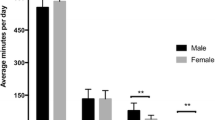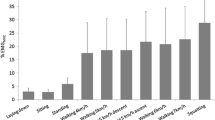Abstract
The aim of this study was to investigate the relationship between maximal anaerobic power (P max) and corresponding optimal velocity (V opt) and habitual physical activity (PA) on the one hand and with maximal oxygen consumption (V˙O2max) on the other hand, in elderly women. Twenty-nine community dwelling, healthy women aged 66–82 years participated in the study. PA was evaluated using the Questionnaire d'Activite Physique Saint-Etienne (QAPSE) and expressed using two QAPSE activity indices: mean habitual daily energy expenditure (MHDEE) and daily energy expenditure corresponding to leisure time sports activities (sports activity). The subjects' P max and V opt were measured while they cycled on a friction-loaded non-isokinetic cycle ergometer. P max was expressed relative to body mass [P max/kg(W · kg−1)], and relative to the mass of two quadriceps muscles [P max /Quadr(W·kgQuadr −1)]. A negative relationship between P max/kg (Spearman's r = −0.56; P < 0.01), P max/Quadr (r = −0.53; P < 0.01) and V opt (r = −0.45; P < 0.05) and age was found. P max/kg was positively associated with MHDEE (r = 0.51; P < 0.01) and sports activity (r = 0.58; P < 0.01), as were P max/Quadr and V opt (r = 0.55; P < 0.01 and r = 0.54; P < 0.01, respectively). P max/kg, P max/Quadr and V opt correlated positively with V˙O2max. The positive relationship between ergometer measurements and PA indices was similar to that between V˙O2max and PA. P max/kg was, moreover, closely related to V opt (r = 0.77; P < 0.001). When a multiple stepwise regression analysis was used to select the variables influencing ergometer measurements, MHDEE contributed significantly to P max/kg variance, whereas sports activity contributed to P max/Quadr and V opt variances. In conclusion, the data from this cross-sectional study suggest that in healthy elderly women habitual PA, and especially leisure time PA, alleviates the decline of the P max of the quadriceps muscles.
Similar content being viewed by others
Author information
Authors and Affiliations
Additional information
Accepted: 30 January 1997
Rights and permissions
About this article
Cite this article
Kostka, T., Bonnefoy, M., Arsac, L. et al. Habitual physical activity and peak anaerobic power in elderly women. Eur J Appl Physiol 76, 81–87 (1997). https://doi.org/10.1007/s004210050216
Issue Date:
DOI: https://doi.org/10.1007/s004210050216




